An experimental account of Germany’s 32nd reunification derby – unfettered, unfair, unhinged.
Written by Alexander Kloß, Photos by Jakob Deutschmann and Alexander Kloß
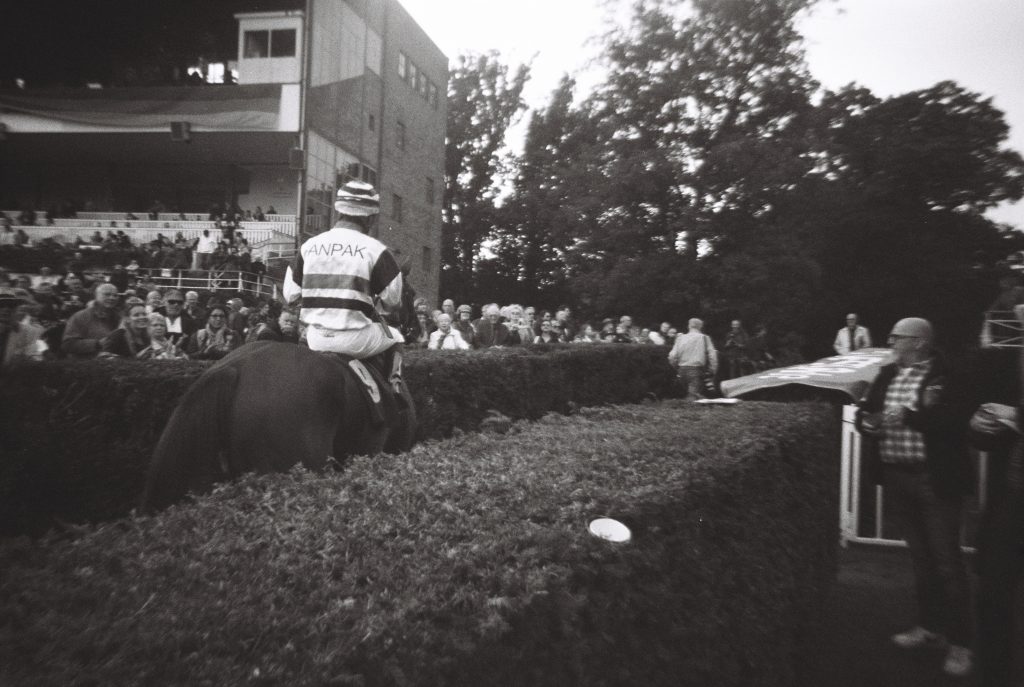
The day of the race started in the mellowest of ways. J’s camera decided to run out of sap, which forced us to revert to his rustic point-and-shoot. The weather, however, was kinder. A weekend of intermittent torrential rainfalls gave way to a Monday of occasional cloudbursting. It was as if the gods were willing and able to add adequate decorum to what would mark Germany’s 32nd reunification day.
We took the train to the elusive Hoppegarten racecourse, which sits just east of the border that separates debaucherous Berlin from barren Brandenburg. Otherwise put, we were ready enter the land of desolate apathy that once nurtured much of my own bloodline. A home game, of sorts. A pan flutist, the likes of which have last appeared to me in an 80s documentary about West Berlin, grazed our waggon for a station or two, in hope that our fascination for Incan culture would somehow surmount our interest in horseracing. Alas, it did not.
We baptized our first beer while switching trains. On the second one, we ran into a man in his best years: past retirement, yet still with a thrill to spare. He sported a snuck suit, the retro look of which revealed that he hasn’t always called the westernmost borough of Zehlendorf his home. A veteran of the scene, he followed horse races since his youth in East Berlin. He rarely makes the trip now, but the German Reunification Race is something that joys him and that is sure to stay put in his calendar. „Back in the days, the races were fixed and if you knew who to talk to, you were in luck“, he says. But these days are long gone and now he is out of the loop.
The press entrance keeps you far away from the maddening crowd that is pushing and shoving past one another to enter the racegrounds. On our way to obtain whichever clearance the staffers would deem most appropriate for us, we crossed into the VIP section. It is managed by an actual countess donning a purple hat and dress that could only be a persiflage (or an hommage, if we’re kind enough) of the likes of Epsom and Aintree. In modern-day Germany, where the monarchy has been banished for a good century, horseracing has become both a niche activity and a fairly proletearian affair, but the October 3 race is the Berlin crowd’s favorite and onlookers from all walks of life streamed in in thousands.
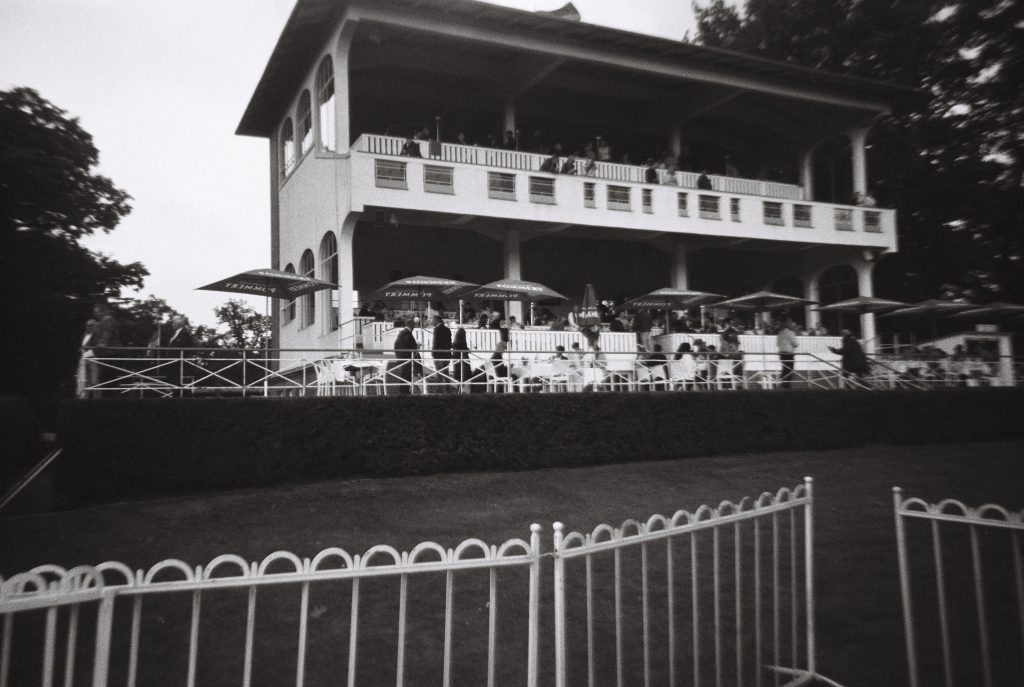
The subtle taste of the bourgeoisie.
Understanding how a horse race works is not exactly hard, but what makes it much more delicate is the intention of turning over a profit from the experience. On this particular occasion, everyone was given eight chances to hit it big. We used the first race to get an overview of the whole ordeal and our place in the grand scheme of things. As it turned out, our place was not exactly in the VIP section, but at least the next closest thing. We got to partake in the race at its most climactic point – the finish. It’s that frantic final stretch where jockeys whip their horses harder than a British politician in need of a majority and where fortunes are won and lost in split-second dramas.
If seeing the race at it’s very apex wasn’t enough already, there’s what could rightly be called Hoppegarten’s racing sanctuary: the control tower. It is a slim, three-storied concrete nail that grates the electronic light trap, the job of which is to break down the order of the race by a thousandth of a second. It’s the humble Houston of Hoppegarten. Just before the second sprint, race control happily took us up the narrow flights of stairs to give us a display of all the high-tech wonders with which to prevent any trackside tinkering. Their most trusted device: a powerful set of binoculars. One of the officials was so eager to show us their semi-automatic wonderland that we became genuinely scared to delay the start of the race and kindly saw ourselves out.
After witnessing the spectacle from the machine room, it was time to try our hand at multiplying our profits. The gentleman on the train told us to trust the racing booklet which we managed to secure upon entering the premises. Besides names of horses, jockeys, and owners, it sports a whole myriad of pseudo-sabermetric measurements from horse color to weight allowances. Having no real knowledge of how much any of this mattered, we turned to the only true gradient of collective (mis)fortune: the odds.
Displayed on small TV screens scattered across the betting booths, a row of seemingly random numbers flashes up. The horrible thing is that these numbers are dynamic: Not only can you hardly see them while filling out your betting slip, but by the time you did the mental calculus of how to hedge your bets, they change again. What you’re dealing with is essentially a reverse stock market: the more people bet on a horse, the lower the payoff. To cut things short, we decided to put our money on the favorite and shuffled down the hedged-off avenue to our front row spots. The only thing between us and our winnings was a breakneck 1400 meter dash that would last for just about a minute and a half.
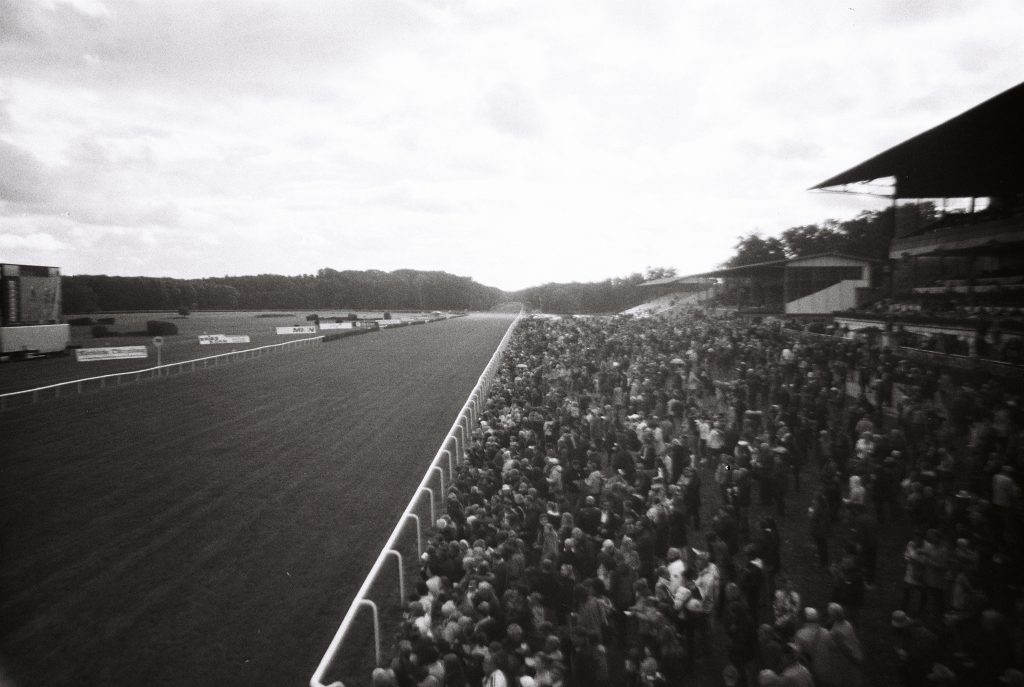
A proletarian affair.
In some ways, spectating a horse race isn’t very different from any other sporting event: You pay to witness some sort of athletic performance that you would almost certainly have a better view on if you watched it at home on your TV. What makes it unique are two things. For one, the cheapest spots are the ones closest to the action, right at the track. And secondly, the closest seats are of course the worst, because you will only see the stallions whizz by for a couple of seconds at best. It’s like a bike race or a marathon, just that these two really have no good in-person spectating options if we’re being honest. Horse racing at least offers you to climb up the grandstand, which is rather far away from the action but which will offer you as good of a view as you could ask for.
The favorite for our fateful first race was called Arnis Master and this is where our money was. As soon the bell rang and the horses set loose, we were ready to witness the madness unfold. Standing directly at the finish line, however, the first minute of the race was spent by us following the action on a giant flatscreen and listening to the frantic commentary echoing from behind us. As we only had the most basic photography supplies with us, getting the timing right was even more important than usual. What made this a lot palatable, however, was that Arnis Master was doing exceedingly well. So well in fact, that he hauled in our first cash-out of the day. It seemed that we were either incredibly lucky or most people around us just didn’t know how to play the game.
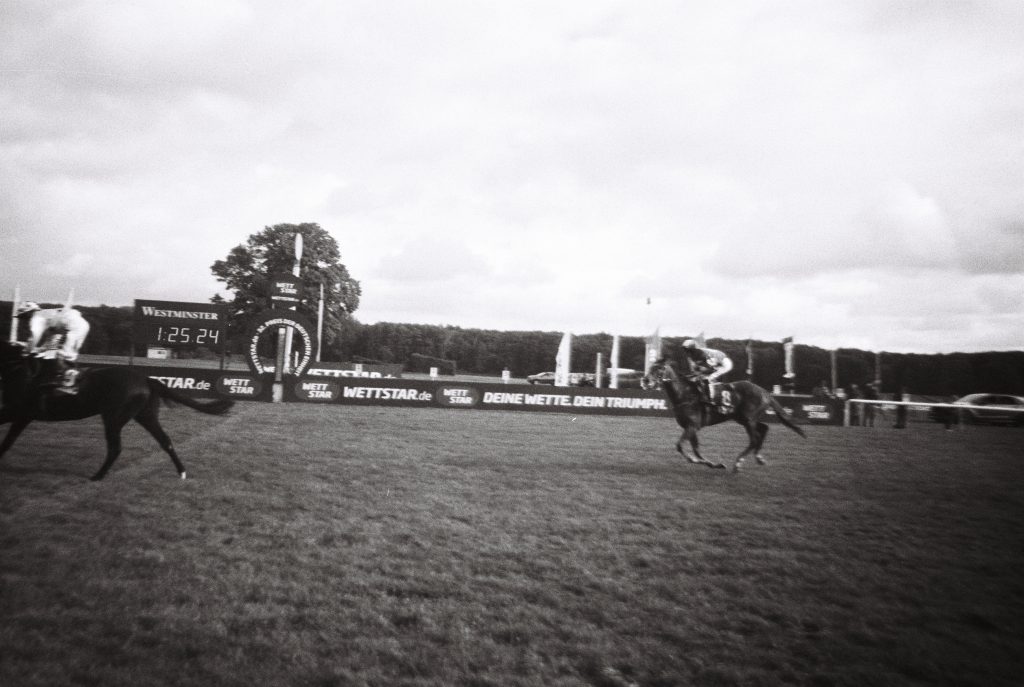
85 seconds to leave your lover.
The longer we stayed, the more apparent it became that we truly were just as clueless as everyone else. The fourth race was won by a horse with a name so corny, I won’t even bother to put it down. By the time the grand prix approached, we had already spent a good three hours of going back and forth between the racecourse, the betting booths, and the press room, whose main amenities were free bottled water, plenty of TVs, and an up-close look at the jockeys during their weigh-in. For the owners – usually stud farms or the occasional studded businessman – 55 grand were on the line. The horses start a bit behind the finish the line and run for almost an entire lap. At two kilometers, it’s the same length as the Kentucky Derby, frequently dubbed the „most exciting two minutes in sports“. It is the reason most people even bothered to turn up on a gray October day.
Long queues lined the betting stalls, with the odds changing every couple of minutes until the very moment the race bell rings. Names such as India, Queroyal, and Best of Lips were making the rounds, with everyone being sure that it must be their favorite to bring home the trophy and whatever was wagered with interest. This time, we made sure to get a good look at the horses before losing yet another bet. Nestled between jockeys and owners on the inside of the parade ring, we were left essentially as clueless as we had started out, with the exception that starter no. 5, Calif, seemed a bit too stubborn for his own good.
With seconds to spare, we headed to the grandstand to get the best possible view for the grand finale. The atmosphere was dense, the excitement palpable. Once they went off, it seemed like forever until the septet of runners and chasers finally approached the final straight. For the longest time, the betting favorite India was dominating what seemed like an unspectacular race, but every overconfident bettor was taught a pricey lesson on that afternoon. A 12-to-1 outsider by the name of Petit Marin („Little Sailor“) caught up to its fellow trailblazer and went head-to-head with the top horse for the final 400 meters. As the gap between the two shrunk, the finish line drew dangerously close. With a breakneck pace up until the very end, the sailorboy managed to steal the show by a horse’s head.

Jockey of the hour René Piechulek.
In a way, it was only befitting that the 32nd „German Unification Grand Prix“ went to René Piechulek, a jockey born in East Germany during the regime’s swan song years. Befitting to the occasion, the grandstands were clad in giant German flags and spectators were given miniature versions to wave around. Until a few years ago, the overly zealous display of national symbols was reserved for foreigners and the FIFA World Cup, but now, showing your true colors unabashedly is back in vogue amongst „true patriots“.
The German anthem plays twice during the event: once before and once after the race. It caught a small group at the press lounge by surprise. Their guide was just about to explain them how the jockeys are given backpacks with extra weights to carry during the race in order to equalize conditions when the first stanza started rolling in to crown the race’s winner. He stops for a moment to ask the flag-clad crowd whether it’s alright to carry on and nobody objects. It’s not the U.S., after all.
In the parade ring, we find an elderly distinguished gentleman from Munich who „most thoroughly enjoyed the occasion“. As for him, the process of reunification is most certainly complete. Piechulek himself seemed a bit more ambivalent in his verdict, stating that in some areas the country has managed to unite, while in others it hasn’t. Then he steps on the podium – there’s no time for unity quarrels when you have a triumph to celebrate.
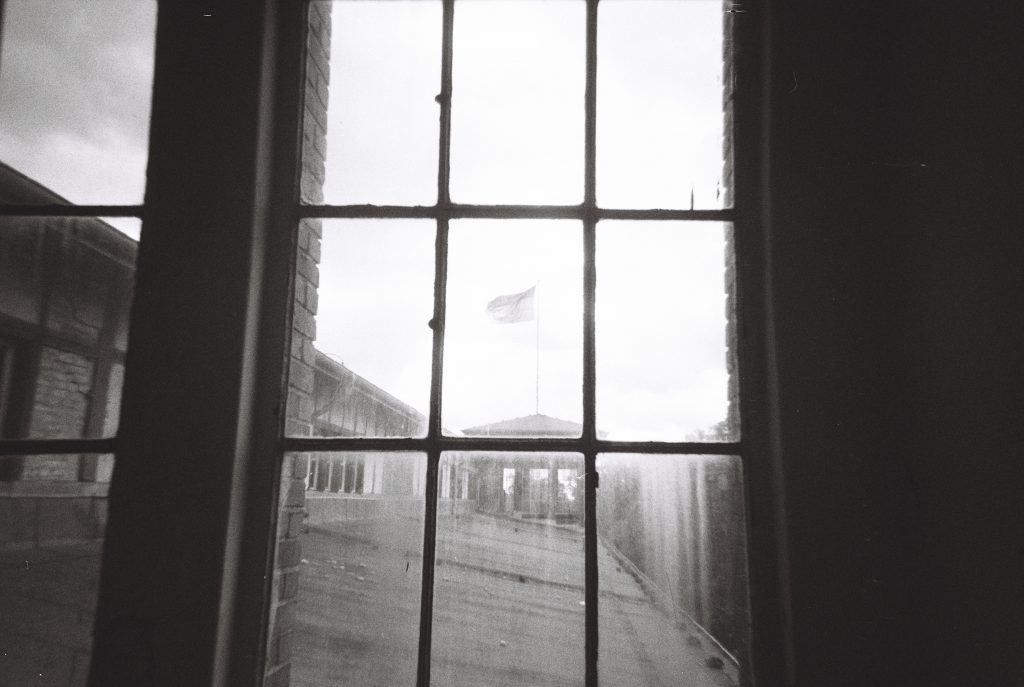
The unspangled banner.
Workers in the German East earn 14 percent less than their counterparts in the West. Although cities such as Berlin and Leipzig are still booming to a point of exhaustion, the East is now as sparsely populated as it was in 1905 while the West has doubled in density. Most of the country’s non-city dwellers are largely cut off from public transport, employment opportunities, and social mobility. Within this insularity, racism, xenophobia, and populism festers. Meanwhile, political parties on both sides of the aisle muddy legitimate concerns for the socioeconomic wellbeing of their citizens with dangerous political agendas that would threaten their livelihood even further. With the average East German owning less than half the assets of a Westerner, however, economic worries still reign supreme in the lands of the former GDR. Much remains to be done to patch up the ailments that reunification not only left unadressed, but sometimes even proliferated. Otherwise, the spectators at Hoppegarten will have no more pocket money left to gamble away and might very well take their flag-waving to the streets, as is already happening in many places across the county. Mostly rural, mostly in the East. But Germany is reunited, all right.
